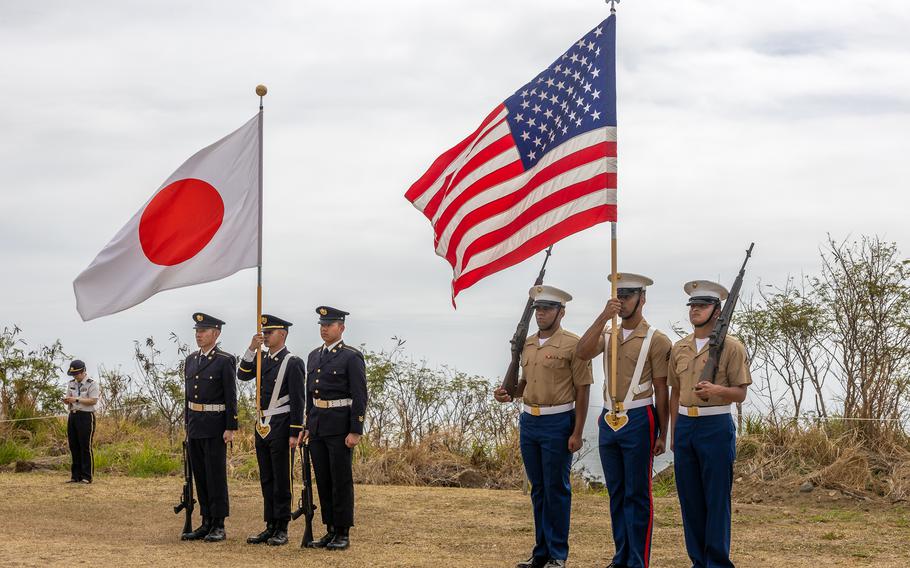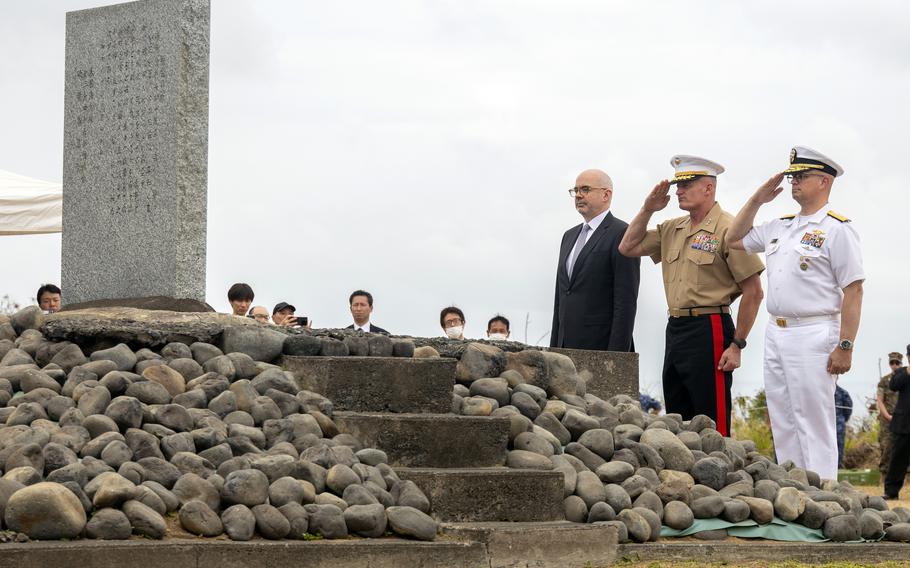
U.S. Marines and Japanese soldiers march during the Reunion of Honor ceremony on Iwo Jima, Japan, March 30, 2024. (Christian Garcia/U.S. Marine Corps)
U.S. Marines and Japanese soldiers marched side-by-side over the weekend on Iwo Jima, where their predecessors fought one of the bloodiest battles of World War II.
The troops, along with family members of those who fought on Iwo Jima and officials from both nations, visited the remote island Saturday for the 79th Reunion of Honor commemorating the pivotal 36-day battle.
Around 170 people took part in the ceremony, but no U.S. World War II veterans came this year to the island now known as Iwo To in Japan, a spokesman for III Marine Expeditionary Force, 2nd Lt. Owen Hitchcock, said in an email Monday.
There are three or four U.S. veterans of the battle who are still alive, however, there was no civilian contract airliner that could bring them to the island for the ceremony, Hitchcock said in a follow-up email. There are no surviving Japanese veterans of the battle, he said.
Last year, several of the few remaining U.S. veterans of the battle were present for the hourlong ceremony. They were joined by as many as 100 members of Japanese families who lost loved ones on the island.

Lt. Gen. Roger Turner, center, commander of III Marine Expeditionary Force, Rear Adm. Carl Lahti, right, commander of U.S. Naval Forces Japan, and Raymond Greene, U.S. deputy chief of mission to Japan, salute the Reunion of Honor monument on Iwo To, Japan, March 30, 2024. (Christian Garcia/U.S. Marine Corps)
The Battle of Iwo Jima began with an amphibious assault by Marines on Feb. 19, 1945, following months of aerial and naval bombardment. The Japanese had dug a defensive labyrinth of tunnels into the island’s volcanic rock.
Of the 70,000 Marines who fought there, more than 6,800 were killed and 19,000 were wounded. About 18,000 died on the Japanese side, with only 216 captured. The island was finally declared secure on March 26, 1945.
The flag-raising atop Mount Suribachi, photographed by The Associated Press’ Joe Rosenthal, helped rally U.S. support for the war effort and became an iconic symbol of American sacrifice and courage.
Those who attended this year’s reunion gathered near a monument on the island’s southern point, overlooking the beach where some of the battle’s heaviest fighting happened.
A video of the ceremony posted on the Defense Visual Information Distribution Service showed U.S. Marines and Japanese soldiers marching shoulder-to-shoulder with American and Japanese flags before members of the Japanese Diet placed wreaths at the monument.
The reunion honors troops from both nations who fought with valor on Iwo Jima, III MEF commander Lt. Gen. Roger Turner said at the gathering.
The troops who gave their lives there “altered the course of history,” he said.
The U.S.-Japan alliance is based on mutual respect, common goals and commitment to a free and open Indo-Pacific, Turner added.
“This ceremony is a solemn reminder of the price of freedom and the cost of peace,” he said.